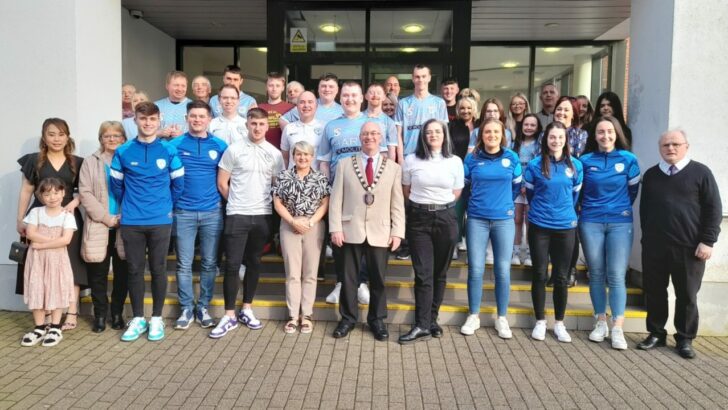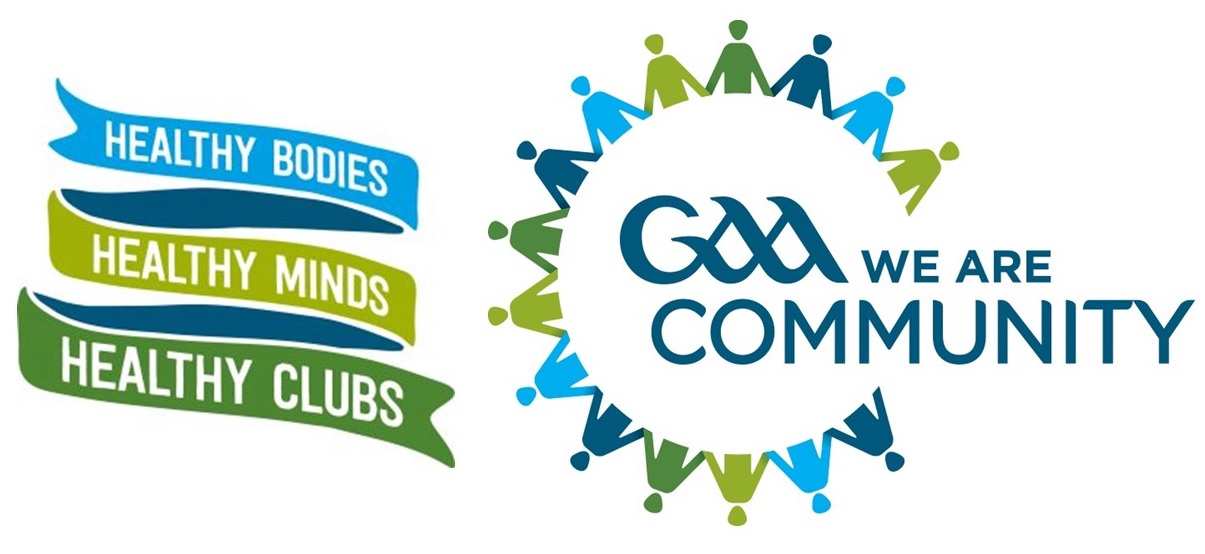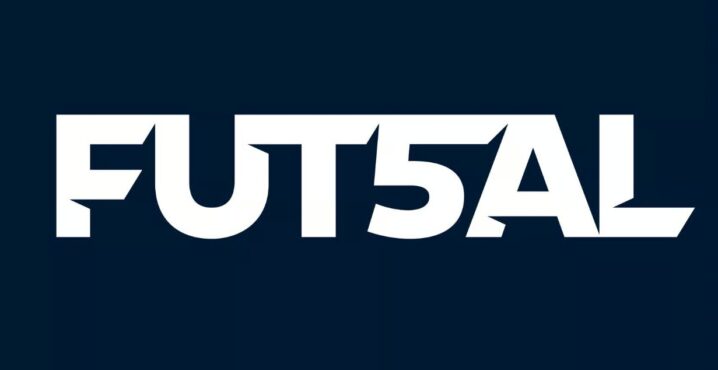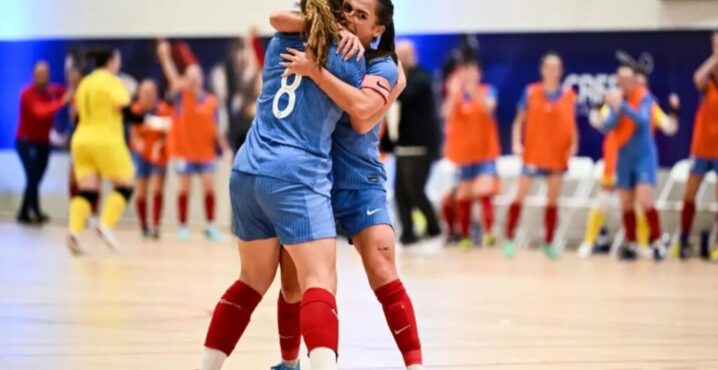Estimated reading time:20 minutes, 24 seconds
From Grassroots Triumph to Award-Winning Excellence: How Omagh Futsal Club’s Success Story Illuminates the Journey to Professional Amateurism
In recent months, Omagh Futsal Club has emerged as a shining example of what can be achieved when grassroots passion meets professional ambition. The club was honored at a special reception hosted by Councillor Thomas O’Reilly, Chair of Fermanagh and Omagh District Council in Northern Ireland (NI). Omagh Futsal Club, co-founded in 2017 by Martin Cassidy and David Alonso, a UEFA A Licensed and Futsal B Licensed Head Coach, has made significant strides in the world of Futsal. Their remarkable journey has been marked by several accolades, including titles such as National Plate Winners, Irish Football Association Futsal Club of the Year, and NI Futsal Federation Club of the Year.
(Main picture source: Fermanagh and Omagh District Council)
Adding to their impressive list of achievements, Omagh Futsal Club’s “Futsal for All” initiative recently clinched the Project of the Year Award at Sport NI’s prestigious SportMaker awards. This accolade highlights the club’s commitment to inclusivity and community engagement, underscoring the impact of their diverse programs, which include disability Futsal, refugee integration, and female-only sessions.
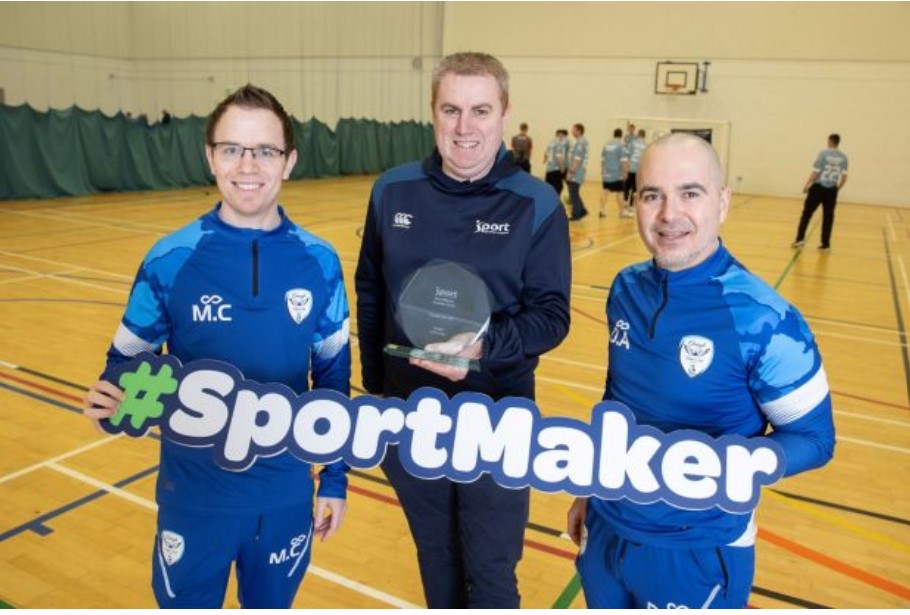
Omagh Futsal Club, co-founded in 2017 by Martin Cassidy (on the left) and David Alonso (on the right) – Source of the image: Sports Council NI
The club’s success story exemplifies the transformative potential of blending grassroots passion with a professional approach. As this article explores, transitioning from amateurism to professional amateurism is not merely about adopting new practices, it is also about enhancing the community spirit that fuels the sport. By focusing on incremental steps, realistic timeframes, and strategies for effective recruitment and collaboration, we will examine how clubs can follow Omagh Futsal’s footsteps to elevate their standards and achieve similar success.
Futsal, the dynamic and fast-paced indoor variant of football/soccer, has captured the hearts of many at the grassroots level. Despite its popularity, much of Futsal remains firmly in the realm of amateurism, characterized by informal organization and limited resources. To unlock its full potential, Futsal clubs need to aspire towards professional amateurism. This evolution can bring about numerous benefits, fostering growth, improving player development, and enhancing community engagement. Here’s how clubs can make this transition, with a focus on incremental steps, realistic time frames, the importance of cooperation within the league environment, and strategies for successful recruitment.
Understanding Amateurism in Futsal
Amateurism in Futsal is the foundation upon which the sport has grown. At this level, the emphasis is on participation for the love of the game, with minimal financial involvement.
- Volunteer-Driven: Clubs rely heavily on volunteers for roles such as coaching, administration, and event organization.
- Basic Facilities: Games are often played in community centers, school gyms, or rented halls with minimal investment in dedicated Futsal infrastructure.
- Limited Financial Resources: Funding comes primarily from small membership fees and local fundraising efforts, restricting the scope of activities and development.
While amateurism fosters a strong sense of community and accessibility, it also imposes limitations that can hinder the sport’s growth and development.
The Need for Professional Amateurism
Professional amateurism combines the passion and community focus of amateur sports with the structure, resources, and professionalism typically associated with professional sports. For Futsal, this shift is not just desirable but necessary to propel the sport forward. “In order to build a sustainable future, sports organizations must adopt professional management practices while maintaining the core values that inspire community participation,” says Simon Chadwick, Professor of Sport Business Strategy and Marketing at the University of Salford.
Reflecting on this journey, Omagh Futsal Co-Chairman Martin Cassidy notes, “Over the years, we have closely followed Futsal Focus, benefiting from a range of insightful articles and conducting our own extensive research on best practices from successful clubs. Our goal has always been to evolve and adapt by learning what truly benefits our community. The recent awards validate our dedication and provide further motivation as we strive to elevate our standards. Our approach is methodical—building step by step and day by day. As long as the club continues to progress, we remain committed and visionary, driving the journey from grassroots to professional amateurism.”
Incremental Steps Towards Professional Amateurism
The stepping stones are based on a club already operating as an amateur club with limited staff, likely operating with the head coach acting as the club’s chairman and a small academy coached by possibly by parents volunteering. It’s about taking the needed steps to expand the club’s foundation to make progress towards the transition to the professional amateur stage. The timeframes provided in the article were synthesized from general sports management principles and practices:
- Structured Management:
- Step 1 (0-2 years): Form an elected committee with defined roles such as President, Treasurer, and Secretary. 0-2 years takes into consideration the time it may take to identify and recruit the right people. Recruit individuals who are passionate and have relevant skills, even if they’re volunteers initially.
- Step 2 (2-4 years): Develop a comprehensive strategic plan with input from experts outlining short-term and long-term goals. If possible secure financial support or a sponsor in order to hire a consultant or organisation to assist with the plan.
- Step 3 (4-6 years): Establish sub-committees for specific areas like finance, facilities, and events.
- Facility Investment:
- Step 1 (0-3 years): Conduct a needs assessment and develop a feasibility study for owning facilities. The start of this process would be included in your comprehensive strategic plan.
- Step 2 (3-7 years): Secure funding through grants, local government support, and community fundraising or if possible attract an investor/s. Begin the process of acquiring land and obtaining building permissions.
- Step 3 (7-15 years): Construct and develop the facilities, incorporating phased improvements as funding allows.
- Financial Management:
- Step 1 (0-2 years): Create a detailed budget and establish basic financial controls. This too would be a part of your comprehensive strategic plan.
- Step 2 (2-5 years): Explore and secure diverse revenue streams such as sponsorship deals, hosting tournaments and local social leagues, and selling merchandise.
- Step 3 (5-10 years): Implement advanced financial management systems and practices to ensure long-term sustainability.
In addition to these steps, it is crucial to emphasize the importance of sustainable growth and the prudent allocation of resources. Overextending financial resources in an attempt to accelerate progress can lead to significant risks, including budget shortfalls and operational disruptions. To ensure long-term stability, clubs should prioritize incremental investments and carefully manage their expenditures. Developing a robust financial plan that balances immediate needs with future goals helps prevent overextension and fosters a sustainable growth trajectory. By adopting a cautious and strategic approach to financial management, clubs can build a solid foundation for ongoing success and avoid the pitfalls associated with rapid, unsustainable expansion.
- Professional Staff:
- Step 1 (1-3 years): Identify key roles and hire part-time staff for essential functions.
- Step 2 (3-7 years): Gradually expand staff roles and increase their hours as the club grows.
- Step 3 (7-15 years): Transition to full-time positions and establish a comprehensive professional development programme for staff.
Integrating Professional and Volunteer Staff
As Futsal clubs transition towards professional amateurism, effectively integrating part-time and full-time staff into a primarily volunteer-driven environment becomes crucial. This integration involves not only defining clear roles but also fostering a collaborative culture that values both professional and volunteer contributions.
Role Definition and Collaboration
Establishing clear boundaries and roles between professional staff and volunteers is essential. Professionals should handle specialized tasks and administrative duties, while volunteers continue to contribute their passion and community-focused efforts. This separation of responsibilities helps avoid overlap and confusion, ensuring that each group can focus on their strengths. Regular joint meetings and collaborative projects can enhance communication and teamwork, reinforcing a shared commitment to the club’s goals.
Maintaining Volunteer Engagement
To keep volunteers motivated, it’s vital to recognize their contributions and involve them in decision-making processes. Implementing a structured recognition program can acknowledge their dedication and hard work, whether through awards, public appreciation, or social events. Providing opportunities for volunteers to participate in planning and feedback sessions not only ensures their voices are heard but also helps them feel integral to the club’s success. By balancing the professional and volunteer roles and maintaining open lines of communication, clubs can create a harmonious environment that leverages the strengths of both groups, ensuring a smooth transition to professional amateurism.
Concerning the timeframes provided, it is important to acknowledge that different clubs might progress at different paces depending on their unique circumstances. Factors such as available resources, community support, and existing infrastructure can significantly influence the rate of transition. Therefore, clubs should use these timeframes as flexible guidelines rather than rigid schedules, adapting them to fit their specific situations and capacities. This approach ensures that clubs can progress sustainably, avoiding overextension and maintaining a steady path toward professional amateurism
Recruitment of Experienced Professionals and University Students
- Step 1 (0-2 years): Engage Retired Professionals
- There is a wealth of untapped potential among retired professionals who possess a significant amount of experience and expertise. By engaging these individuals for part-time roles, clubs can bring invaluable skills and knowledge that can significantly enhance operations and mentoring. Retired professionals can commit to working 1-2 days a week, offering strategic guidance, training, and administrative support. Their involvement can help streamline processes, introduce best practices, and provide mentorship to both staff and players, fostering a culture of growth and professionalism within the club.
- Step 2 (2-4 years): Develop Partnerships with Universities
- Establishing partnerships with local universities can be mutually beneficial. Clubs can recruit students for internships and temporary positions during holiday breaks, providing students with practical experience in a sports management environment. This not only helps clubs with additional manpower but also gives students valuable insights and experience that can enhance their resumes. Students would also be doing a Degree Dissertation or a Master’s thesis which could lead to collaborating/ research opportunities and the application of new sports and business management approaches.
- Step 3 (4-6 years): Create Structured Programmess for Practical Experience
- To maximize the benefits of involving both retirees and university students, clubs should develop structured programmes that clearly define roles, expectations, and outcomes. These programmes should offer practical experiences that are both challenging and rewarding, helping participants to develop skills that are directly applicable to their future careers. For retirees, it provides an opportunity to stay engaged and contribute their expertise to a growing club. For students, it offers a stepping stone into the professional world, with the added benefit of having real-world successes to showcase to future employers. By emphasizing how these roles can enhance career prospects, clubs can attract highly motivated individuals who are eager to make meaningful contributions.
League and Club Cooperation: Enhancing Collaborative Success
The transition to professional amateurism in Futsal is greatly influenced by the surrounding environment, including the league structure and relationships with other clubs. Successful collaboration and support within this ecosystem can significantly boost a club’s progress and sustainability. As Roger Pielke Jr. Professor of Environmental Studies and a sports policy expert at the University of Colorado Boulder notes, “The blending of professional management with amateur sport can drive development, enhance organizational stability, and improve the overall quality of the sporting experience.”
Competitive League Structure
To foster a successful transition, clubs should be part of well-organized leagues that:
- Support structured competitions, regular fixtures, and fair play.
- Provide guidelines and resources for clubs aiming to professionalize, such as facility improvement and financial management support. And if this is not being provided then this discussion needs to happen with your league and the governing association.
Key Collaborative Strategies
- Peer Learning
- Clubs can benefit from sharing best practices, successes, and challenges with each other. This exchange of knowledge helps in refining operational strategies and overcoming common obstacles.
- Resource Sharing
- Jointly organizing events or sharing facilities can reduce costs and enhance experiences for all involved. For instance, clubs can collaborate on tournaments or training sessions, making better use of available resources.
- Mentorship Programmes
- More advanced clubs can mentor newer or smaller clubs, offering guidance and support. This approach fosters a culture of shared learning and mutual benefit, helping less experienced clubs navigate the transition to professional amateurism.
- Practical Engagement Initiatives
- Successful examples include joint marketing campaigns where multiple clubs collaborate on community events. This not only shares costs but also enhances collective visibility. Establishing league-wide mentoring programs where experienced clubs offer guidance to newer ones is another effective strategy.
- Platform for Best Practices
- Leagues can facilitate platforms for clubs to exchange best practices and innovations in management. This can be achieved through formal league structures or informal networks, providing opportunities for clubs to enhance operational capabilities and expand their community reach.
Expanding Collaboration
Clubs should actively participate in league meetings, networking events, and propose joint projects. By doing so, they can forge stronger relationships within the league and with other clubs, contributing to a more robust and supportive sports ecosystem.
The path to professional amateurism is supported significantly by a collaborative environment within leagues and among clubs. Through strategic partnerships, shared initiatives, and a commitment to peer learning and resource sharing, clubs can enhance their operational effectiveness and contribute to a thriving Futsal community. By leveraging these cooperative efforts, Futsal clubs can progress steadily toward their professional amateurism goals while maintaining the core values that inspire community engagement and love for the game
Community Engagement: Building a Healthy and Inclusive Environment
Building strong relationships with local businesses, schools, and community organizations can provide additional support and resources. Engaging the community through events, outreach programmes, and partnerships can increase visibility and participation. In addition, it would be beneficial to include more specific examples of successful community engagement strategies and their tangible benefits.
Successful Community Engagement Strategies
- Community Outreach Programmes:
- Youth Clinics: Hosting youth clinics can introduce children to futsal and promote physical activity from a young age. These clinics help foster a love for the sport and can attract future members.
- Health and Wellness Workshops: Organizing workshops on nutrition, mental health, and first aid can benefit both club members and the wider community, enhancing the club’s role as a community health promoter.
- Local Sports Festivals: These events can bring the community together, showcase the club, and offer a platform for local talent to shine.
- Partnerships with Local Schools:
- Collaborate with schools to offer educational programmes that integrate physical education with academic learning, encouraging a balanced lifestyle among students.
- Programmes like “school sports days” or “after-school clubs” can provide a structured environment for children to engage in futsal and learn important life skills.
- Charity Events:
- Organizing charity matches and events can raise funds for local causes, drawing community members to support both the cause and the club.
- Partnering with local businesses for these events can enhance sponsorship opportunities and create a mutually beneficial relationship.
Case Study: The GAA Healthy Club Project
A compelling example of community engagement through health promotion is the Gaelic Athletics Association (GAA) Healthy Club Project (HCP) in Ireland. This initiative shows how sports clubs can extend their impact beyond their specific sport to foster overall community well-being.
Highlights from the GAA Healthy Club Project:
- Health Promotion Efforts: Eighteen GAA clubs participated in the HCP, transitioning from moderately to highly health-promoting entities. They implemented 72 health initiatives focusing on physical activity, emotional well-being, and health awareness.
- Community Impact: Clubs viewed health promotion as a natural extension of their existing efforts, with tangible positive outcomes for members and the broader community. This approach helped build a positive reputation and strengthened community ties.
“Health promotion was a natural progression of the work already underway in our club,” said a representative from one of the participating clubs. “We could see the positive implications for our members and the wider community.”
Applying Lessons to Futsal Clubs
Futsal clubs can draw inspiration from the GAA Healthy Club Project by implementing similar health-focused initiatives:
- Health Promotion Initiatives: Develop programs that promote physical activity, mental health, and health awareness within the club and the broader community.
- Community Partnerships: Collaborate with local health organizations, schools, and community centers to deliver health promotion activities.
- Inclusive Programs: Offer sessions specifically designed for different community groups, such as disability futsal, refugee integration, and female-only sessions.
By incorporating these strategies, futsal clubs can significantly enhance their community engagement, fostering a healthier, more inclusive environment. These initiatives not only attract new members and volunteers but also build a positive reputation, strengthen community ties, and create additional revenue opportunities through local sponsorships and partnerships.
Leveraging health promotion as a tool for community engagement not only aligns with the values of amateur sports but also contributes to the overall well-being of club members and the broader community. The rules of futsal, with its roll-on and roll-off substitutes, make it an ideal activity for engaging groups such as taxi and bus drivers, who may be seeking to improve their health and fitness. The short, manageable periods of participation can help these individuals achieve their health goals. Enjoying the sport could also attract them to the club, leading to increased involvement in volunteer roles, with some bringing their families to games. As the initiative grows along with awareness, it could also appeal to a wider audience, as the health benefits are highlighted through local newspaper articles and on social media.
Addressing Key Challenges in Transitioning to Professional Amateurism
As Futsal clubs move towards professional amateurism, they encounter several key challenges:
- Financial Constraints: Securing sufficient funds for facilities and professional staff is crucial. Effective strategies include diversifying revenue sources, creating detailed financial plans, and pursuing grants and sponsorships.
- Community Resistance: Clubs may face resistance from members accustomed to the traditional amateur model. To mitigate this, it’s important to maintain transparent communication, highlight successful transitions, and involve the community in the planning process.
- Lack of Expertise: Smaller clubs often lack expertise in areas such as financial management and facility development. Engaging experts, investing in staff training, and collaborating with educational institutions can address this gap.
- Infrastructure Challenges: Developing or upgrading facilities requires careful planning and phased implementation. Engaging local authorities and managing costs effectively are key strategies.
- Maintaining Volunteer Engagement: As clubs become more professional, retaining volunteers’ enthusiasm is essential. Recognizing their contributions, providing development opportunities, and fostering a collaborative culture can help.
- Balancing Professionalism with Grassroots Values: Maintaining community engagement while adopting professional practices is vital. Ensuring that core values are integrated into the club’s operations and involving stakeholders in decision-making will help retain the grassroots spirit.
By focusing on these strategies, Futsal clubs can navigate the transition to professional amateurism effectively, ensuring sustainable growth and a strong community connection.
Research and Benchmarking
Several academic studies and books provide insights into the transition from amateurism to professional amateurism in sports clubs. These studies can serve as valuable resources for Futsal clubs aiming to make this transition:
- An evaluation of the transition from an amateur to professional culture within Hong Kong’s Elite Rugby Programme
- This study examines Hong Kong’s transition from amateur to professional rugby, focusing on the Elite Rugby Programme (ERP). Through interviews with eleven professional players, the ERP’s Head, and a sport psychologist, the research identifies key themes: the need for change from an amateur environment, the essential building blocks for creating a professional culture, effective leadership and stakeholder management strategies, and ongoing challenges in sustaining a professional culture. The findings offer valuable insights for practitioners and leaders involved in cultural transformations within emerging sports programs.
- The Business of Sport Management
- The Business of Sport Management is a pioneering book designed for current and aspiring sports managers, providing essential tools and insights for success in the sport industry. Aimed at students in sports, leisure, and business studies, and valuable for practitioners, the book combines theory with practical application, covering management theories, finance, human resources, marketing, and contemporary issues like sponsorship, risk management, and media. Authored by experts from the UK, Europe, and Australia, it offers a global perspective with diverse sports examples to illustrate key concepts.
- Managing Sport Organizations: Responsibility for Performance
- Now in its thoroughly revised third edition, Managing Sports Organizations remains the most engaging and student-centric introduction to sport management. The book bridges theory and practice, covering essential topics such as management principles, decision-making, strategy, organizational design, leadership, human resource management, and facility management. It has expanded its coverage to include contemporary issues like corporate responsibility, ethics, social media, career pathways, and international sport. Featuring case studies, management exercises, study questions, and key term definitions, this textbook provides a comprehensive foundation for courses in sports management, administration, and organization, blending rigorous business principles with the dynamic nature of the sport industry.
- Leadership Style in Amateur Club Sports: A Key Element in Strategic Management
- This study explores how different leadership styles of presidents (managers) in amateur sports clubs impact employee effort, efficiency, and satisfaction. Using the Multifactorial Leadership Questionnaire, researchers found that transformational leadership is the most commonly used style among the 334 managers surveyed. The study reveals that leadership style significantly influences employees’ effort, effectiveness, and satisfaction, with transformational and transactional styles predicting higher levels of extra effort, perceived effectiveness, and satisfaction. Notably, there are differences between managers of team and individual sports regarding efficiency and satisfaction, but the type of sport and gender of the manager do not significantly affect these outcomes. The findings underscore the importance of leadership training in enhancing the stability and sustainability of sports clubs.
The journey from amateurism to professional amateurism represents a transformative phase for Futsal clubs, aimed at blending the community spirit of grassroots play with the strategic benefits of a more structured and professional approach. This transition, while challenging, opens doors to substantial growth, enhanced player development, and deeper community engagement.
To navigate this path successfully, clubs must take a methodical and strategic approach. Key steps include establishing structured management, investing in facilities, diversifying financial resources, and gradually expanding professional staff. The incremental nature of these steps—ranging from foundational planning and community involvement to sophisticated financial and operational strategies—ensures that clubs can grow sustainably without overextending their resources.
Equally important is the role of collaboration within the league environment. By engaging in peer learning, resource sharing, and mentorship programs, clubs can leverage collective expertise and support. This collaborative network not only enhances operational effectiveness but also fosters a robust and cohesive sports ecosystem.
Addressing the challenges of financial constraints, community resistance, lack of expertise, infrastructure development, and volunteer engagement is crucial. Clubs must employ strategic measures to mitigate these challenges, ensuring that the transition enhances rather than disrupts the core values of the sport.
Moreover, community engagement remains a cornerstone of this evolution. By implementing targeted outreach programmes and forging partnerships with local organizations, clubs can build a strong community presence, drive participation, and secure additional resources.
In conclusion, the path to professional amateurism is not just about adopting new practices but also about preserving and enhancing the fundamental values that make Futsal a beloved sport. Through careful planning, strategic investments, and collaborative efforts, Futsal clubs can achieve a balance that fosters growth, sustains community connections, and elevates the sport to new heights. By embracing these principles, Futsal clubs can pave the way for a vibrant future, ensuring that their transition to professional amateurism is both successful and sustainable.
The author of the article
Stephen McGettigan, founded Futsal Focus in November of 2012. Before launching the media platform, he finished an MBA in Football Industries and worked in the football and sports industry in golf, futsal and football including organizations such as @Futsal Group, Irish Football Association, UEFA, NBC Sports Golf Channel, and the Sports Council for Northern Ireland.
Organ Donation
Futsal Focus is a supporter of Dáithí Mac Gabhann and his family’s campaign to raise awareness of Organ Donation. We encourage our readers to learn more about Organ Donation: https://www.organdonation.nhs.uk/
Futsal Focus
You can read more articles about domestic futsal by going to the top navigation bar or by clicking here
If you like this article and would like to keep updated on Futsal news, developments, etc then you can now follow Futsal Focus via Google News by following our page which will send you an alert as soon as we publish an article so please click here and follow us on Google.
You can also keep updated on Futsal news, developments, etc then please submit your email below in the Subscribe to Futsal Focus option.
Follow Futsal Focus by clicking on Facebook, Twitter, or Instagram or on the social media buttons on the website

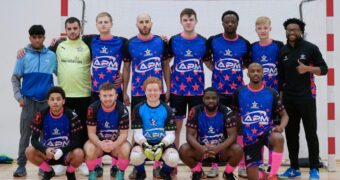

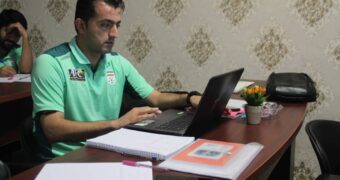



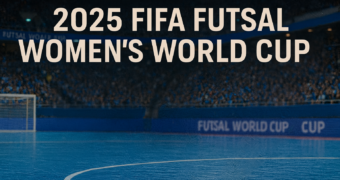

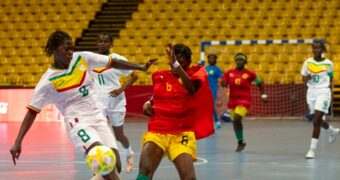
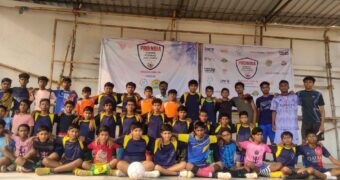
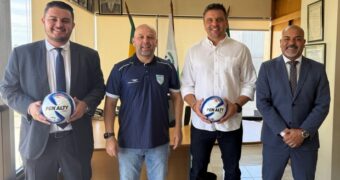




![Validate my RSS feed [Valid RSS]](https://www.futsalfocus.net/wp-content/uploads/2020/01/valid-rss-rogers.png)

